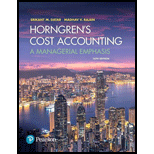
Concept explainers
Budgeting and ethics. Jayzee Company manufactures a variety of products in a variety of departments and evaluates departments and departmental managers by comparing actual cost and output relative to the budget. Departmental managers help create the budgets and usually provide information about input quantities for materials, labor, and
Kurt Jackson is the manager of the department that produces product Z. Kurt has estimated these inputs for product Z:
| Input | Budget Quantity per Unit of Output |
| Direct material | 8 pounds |
| Direct manufacturing labor | 30 minutes |
| Machine time | 24 minutes |
The department produces about 100 units of product Z each day. Kurt’s department always gets excellent evaluations, sometimes exceeding budgeted production quantities. For each 100 units of product Z produced, the company uses, on average, about 48 hours of direct manufacturing labor (eight people working 6 hours each), 790 pounds of material, and 39.5 machine-hours.
Top management of Jayzee Company has decided to implement budget standards that will challenge the workers in each department, and it has asked Kurt to design more challenging input standards for product Z. Kurt provides top management with the following input quantities:
| Input | Budget Quantity per Unit of Output |
| Direct material | 7.9 pounds |
| Direct manufacturing labor | 29 minutes |
| Machine time | 23.6 minutes |
Discuss the following:
- 1. Are these budget standards challenging for the department that produces product Z?
- 2. Why do you suppose Kurt picked these particular standards?
- 3. What steps can Jayzee Company’s top management take to make sure Kurt’s standards really meet the goals of the firm?
Learn your wayIncludes step-by-step video

Chapter 6 Solutions
Horngren's Cost Accounting: A Managerial Emphasis (16th Edition)
Additional Business Textbook Solutions
Gitman: Principl Manageri Finance_15 (15th Edition) (What's New in Finance)
Financial Accounting: Tools for Business Decision Making, 8th Edition
Operations Management
Fundamentals of Management (10th Edition)
Corporate Finance (4th Edition) (Pearson Series in Finance) - Standalone book
 Cornerstones of Cost Management (Cornerstones Ser...AccountingISBN:9781305970663Author:Don R. Hansen, Maryanne M. MowenPublisher:Cengage Learning
Cornerstones of Cost Management (Cornerstones Ser...AccountingISBN:9781305970663Author:Don R. Hansen, Maryanne M. MowenPublisher:Cengage Learning Managerial Accounting: The Cornerstone of Busines...AccountingISBN:9781337115773Author:Maryanne M. Mowen, Don R. Hansen, Dan L. HeitgerPublisher:Cengage Learning
Managerial Accounting: The Cornerstone of Busines...AccountingISBN:9781337115773Author:Maryanne M. Mowen, Don R. Hansen, Dan L. HeitgerPublisher:Cengage Learning Managerial AccountingAccountingISBN:9781337912020Author:Carl Warren, Ph.d. Cma William B. TaylerPublisher:South-Western College Pub
Managerial AccountingAccountingISBN:9781337912020Author:Carl Warren, Ph.d. Cma William B. TaylerPublisher:South-Western College Pub Financial And Managerial AccountingAccountingISBN:9781337902663Author:WARREN, Carl S.Publisher:Cengage Learning,
Financial And Managerial AccountingAccountingISBN:9781337902663Author:WARREN, Carl S.Publisher:Cengage Learning, Excel Applications for Accounting PrinciplesAccountingISBN:9781111581565Author:Gaylord N. SmithPublisher:Cengage Learning
Excel Applications for Accounting PrinciplesAccountingISBN:9781111581565Author:Gaylord N. SmithPublisher:Cengage Learning




